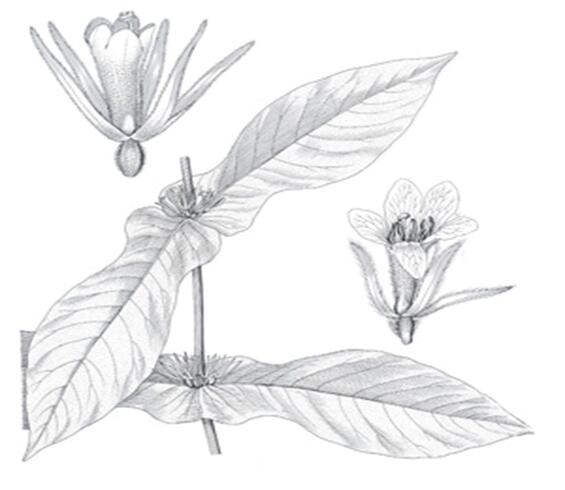- Scientific name: Triosteum perfoliatum
- Species of Greatest Conservation Need (MA State Wildlife Action Plan)
- Endangered (MA Endangered Species Act)
Description

Broad tinker’s-weed (also known as wild coffee or horse-gentian), a member of the honeysuckle family, is a coarse herb which grows up to 13 dm (4 ft) tall but is usually less than 9 dm (3 ft) in Massachusetts. One to six stout stems grow from a common base. Leaves are obovate or obovate-oblong, 10-22 cm (4-9 in) long, 4-10 cm (1.5-4 in) wide, abruptly narrow below the middle, fused around the stem, and usually softly pubescent beneath. Purplish brown or greenish sessile (stalkless) flowers grow in groups of 1 to 4 from each axil. The sepals are 10-18 mm (0.25-0.75 in) long, finely and uniformly pubescent on back and margin, and often glandular. The slight fleshy fruit is greenish orange to orange-red and very conspicuous in summer/fall.
Wild coffee, Triosteum aurantiacum (also called tinker’s-weed or horse-gentian), is very similar to broad tinker’s-weed, and the two have been considered varieties of the same species by some authors. However, wild coffee is readily separable by its much narrower leaves which are not broadly joined around the stem – only a narrow connector can be seen around the stem connecting the bases of the leaves. Ordinarily, it prefers more mesic (moderately moist) conditions than broad tinker’s-weed.
Life cycle and behavior
Population status
Broad tinker’s-weed is currently listed as endangered in Massachusetts. MassWildlife’s Natural Heritage & Endangered Species Program database has 18 records from 5 counties: Barnstable, Dukes, Norfolk, Nantucket, and Plymouth. Eight of those records are within the last 25-year period. The species is also considered rare in Rhode Island, Delaware, Georgia, Kentucky, Louisiana, and North Carolina.
Distribution and abundance
Broad tinker’s-weed grows from Massachusetts to southern Minnesota and south to northern Georgia, Louisiana, and eastern Texas.

Habitat
In general, broad tinker’s-weed is found in dry, open woods or thickets, usually shunning dense shade. Two stations are situated on top of shell middens from Native American camp sites, and one is in a shrubby coastal heathland. Associated plant species include wild columbine (Aquilegia canadensis) and agrimony (Agrimonia gryposepala).
Healthy habitats are vital for supporting native wildlife and plants. Explore habitats and learn about conservation and restoration in Massachusetts.
Threats
Habitat succession, from more open or shrubby conditions to densely forested, is apparently the main reason for rarity here. This condition has resulted from a widespread halt in cutting and burning.
Conservation
Contact
| Date published: | May 7, 2025 |
|---|